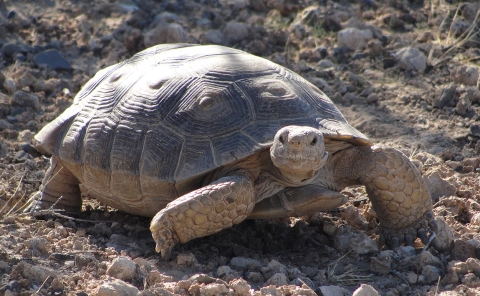The U.S. Fish and Wildlife Service (Service) listed the Mojave desert tortoise (Gopherus agassizii) as threatened under the Endangered Species Act (Act) in 1990 due to habitat loss and fragmentation, excessive predation, and disease. Since then, the Service has been working to protect desert tortoises and their habitat and to recovering the species.
The Service’s 1994 and 2011 recovery plans defined key areas where it would work with other agencies to recover desert tortoises; these key areas are primarily federal and state lands that have some designation as being managed for conservation. However, the Service acknowledges that it and other agencies do not have the resources to conserve desert tortoises everywhere they currently live. For example, desert tortoises continue to occur in low densities over large areas of non-federal land in California. Since “taking” – killing, wounding, harming or capturing a federally listed animal species – violates the Act, the Service can issue incidental take permits for projects on non-federal lands. The goal with these permits is to protect desert tortoises and offset the impacts of projects “to the maximum extent practicable.”
The permit process requires applicants to prepare a conservation plan that describes how many individuals are likely to be taken, the measures the applicant will use to minimize and mitigate that take, the funding to implement these measures, and any other measures the Service may require as being necessary or appropriate.
The Service can advise applicants on the best way to meet the criteria to receive an incidental take permit, but the contents of the conservation plan are ultimately up to the applicants. The Service makes applications for incidental take permits available to the public for review, conducts an analysis of the effects of the Service’s action under the National Environmental Policy Act (NEPA), and – if the applicant has met the issuance criteria in the Act – issues the permit.
Meeting the issuance criteria for an incidental take permit is relatively straightforward; however, the processing of individual permits is time consuming and complex. Therefore, the Service also offers general conservation plans to help expedite the process. In a general conservation plan, the Service “narrows the sideboards” for a permit required by the Act to provide much more specific guidance to applicants. As with a standard incidental take permit, the Service notifies the public and conducts analysis under NEPA on the general conservation plan. Any applicant agreeing to meet the standards in the general conservation plan can receive their specific incidental take permit in substantially less time.
The Service is in the initial stages of a draft environmental impact statement for a general conservation plan for desert tortoises in California. The plan would streamline the issuance of incidental take permits covering the construction, operation, and maintenance of various types of projects, such as renewable energy facilities, commercial buildings, and utilities in the permit area.
The Service held two pre-scoping meetings in June to provide the public with information on this proposed effort, listen to concerns, and answer questions. Below are some of the key questions and answers discussed during those meetings.
Could a proponent use this general conservation plan to develop a project anywhere in the range of the desert tortoise?
No. The general conservation plan would be available for use only on non-federal lands in California outside of desert tortoise conservation areas. The Service’s 2011 recovery plan for the desert tortoise recommends managing blocks of suitable habitat as conservation areas. These conservation areas include desert tortoise habitat within critical habitat, areas of critical environmental concern, National Park Service lands, California Desert National Conservation Lands, and other conservation areas or easements managed for the conservation of desert tortoises. View a draft map of the permit area where the general conservation plan would apply.
Would all project proponents in the permit area have to use the general conservation plan?
No. The Service would recommend that a project proponent make use of the general conservation plan only for projects that are reasonably certain to take a desert tortoise. That standard is the Service’s current policy; it would not change under the general conservation plan.
What projects or activities would the general conservation plan cover?
The general conservation plan would cover development, operation, and maintenance of commercial (e.g., renewable energy projects), agricultural, residential, and infrastructure projects and recreational activities within the permit area, provided they meet its established sideboards. Although the Service’s guidance suggests that general conservation plans should be used for a single type of project, the broader use in this case is appropriate because most projects affect desert tortoises in the same manner. If an applicant proposed a specific project that was likely to affect desert tortoises differently than what was analyzed in the general conservation plan, the Service would inform the applicant that use of the general conservation plan was not appropriate and would rely on a separate process for that project.
Would the general conservation plan increase the amount of development in the desert?
Applying for an incidental take permit from the Service is only one of numerous steps that any proponent must take to implement a project on non-federal lands. At this time, the Service does not envision that desert tortoises present a substantial obstacle to development in the permit area, at least in part because the requirements of the State of California’s Endangered Species Act. However, the Service will analyze this issue in the environmental impact statement that it prepares.
How would the general conservation plan work once completed?
The process of the Service and applicant discussing site- and project-specific issues would not change from current practice; the Service would continue to work with applicants early in their planning processes to determine the appropriate means of meeting the issuance criteria for an incidental take permit. Once the Service and applicant reached agreement on the details, the applicant would use a checklist to demonstrate how the proposed project was meeting the issuance criteria in the general conservation plan. The Service would review this information to ensure that it meets the issuance criteria and issue an incidental take permit to the applicant, if appropriate. The Service would not notice the specific project in the Federal Register at the time of application as it would during a standard incidental take permitting process. The Service expects that most projects reviewed under the general conservation plan would participate in local planning and the California Environmental Quality Act process. The Service would encourage project proponents and local agencies to note that compliance with the Act, if required, would likely occur through the general conservation plan.
Can a general conservation plan benefit the desert tortoise more than the current practice?
The general conservation plan would have both direct and indirect benefits for the desert tortoise beyond the current practice. The Service envisions that the desert tortoise would directly benefit because the general conservation plan would clearly and specifically describe the most appropriate means of minimizing adverse effects to individual animals during the implementation of projects and of mitigating those effects by directing compensation to areas identified in the 2011 recovery plan as being crucial to the recovery of the species. Indirect benefits to the desert tortoise include increased Service staff time to spend working with various partners to implement on-the-ground recovery actions for the species.
Would the general conservation plan establish new conservation areas for the desert tortoise?
No. The Service would use the land use allocations developed by the Bureau of Land Management (Bureau) for public lands in the Desert Renewable Energy Conservation Plan. The permit area proposed is based on existing land ownership patterns; the Service would not propose any changes to these boundaries.
Is the California Department of Fish and Wildlife involved with the general conservation plan?
The Service has initiated general discussions with the California Department of Fish and Wildlife (Department) regarding the general conservation plan since close coordination between the Department and Service is necessary for every incidental take permit to ensure that the agencies are not providing conflicting direction to applicants. At this time, the Service envisions a process in which the Department, Service, and applicant coordinate early and closely during project planning. Such a process would streamline and facilitate the issuance of incidental take permits for both the Service and Department while increasing protection for and conservation of desert tortoises.
How would the Bureau of Land Management be involved?
The Bureau would be involved in two ways. First, in most cases, the Service envisions that project proponents would translocate most desert tortoises found on project sites on private lands to suitable habitat on public lands within areas of critical environmental concern and California Desert National Conservation Lands or on private lands being used as mitigation banks or ecological reserves. Any translocations to public lands would require decisions on the part of the Bureau; the environmental impact statement will include analysis of the translocation of desert tortoises to conservation areas on public lands.
Second, the Bureau and Department have developed a durability agreement that allows for project mitigation to occur on Bureau-administered lands with the Bureau’s agreement at the project level. Land acquisition will remain an important component of mitigation but the durability agreement allows for the agencies to apply the full suite of recovery actions for the desert tortoise across all conservation areas.
Next steps
Soon, the Service will publish a notice of intent to prepare a draft environmental impact statement for the general conservation plan for desert tortoises in California in the Federal Register, including a public comment period. The Service is planning a news release announcing the date of availability. The public can assist in this planning effort by commenting on the draft general conservation plan during the scoping and review of the draft environmental impact statement.
The Service envisions that the general conservation plan will expedite the individual incidental take permitting process, increase protections afforded to desert tortoises for projects in the permit area, focus mitigation associated with the permits within conservation areas, and allow for more staff time to work on conservation efforts for the species.





